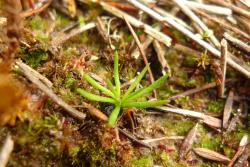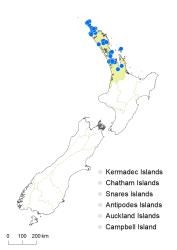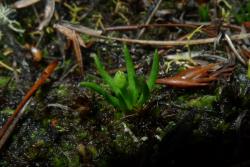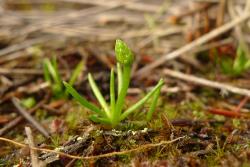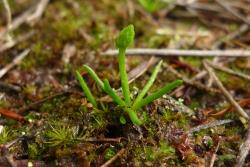- ≡ Huperzia drummondii (Kunze) Christenh. & H.Schneid. in Christenhusz et al., Phytotaxa 19: 20 (2011)
- = Lycopodium sanguisorba Spring, Mém. Acad. Roy. Sci. Belgique 24: 36 (1849)
Horizontal stems absent; plant growing from a subterranean tuber. Stems erect, unbranched, 11–50 mm long. Leaves whorled at ground level, spreading, linear, apices acuminate, margins entire, bases adnate, 7–20 mm long, 0.5–1.0 mm wide, dull green. Sporophylls appressed when young, spreading at maturity, ovate, apices acuminate, margins entire, bases subpeltate to peltate, 1.2–3.0 mm long, 0.7–1.5 mm wide, aggregated into distinct strobili. Strobili solitary, terminal on leafless stalk, erect, green to yellow-brown, 3–9 mm long, 2–5 mm wide.
Phylloglossum drummondii is the smallest member of New Zealand’s Lycopodiaceae and easily overlooked in the wild. It is an ephemeral species, appearing above ground only in winter and early spring. It grows from an underground tuber and is distinguished by a basal rosette of linear leaves, and an unbranched, leafless stalk that bears a single short strobilus.
North Island: Northland, Auckland.
Altitudinal range: 0–240 m.
Phylloglossum drummondii has been recorded in coastal and lowland sites from Te Paki to the Waikato River, with sporadic occurrences reported as far south as Banks Peninsula (de Lange et al. 2010). However, it is now confined to gumland areas in the far north around Kaitāia, growing from near sea-level up to 240 m on the Ahipara Plateau. According to Cheeseman (1906), the species was “said to have been gathered near Picton by Helms, and on Banks Peninsula by Armstrong, but I have seen no specimens”. The plant was recorded by Armstrong (1880) from Banks Peninsula, based on collections made by him and his father, but no voucher material has been found in AK, CHR, MEL or WELT. The origin of the Picton record is unknown.
Also Australia (Western Australia, South Australia, Victoria, Tasmania).
Phylloglossum drummondii favours open gumland or sandy soil under mānuka and other scrub that has been recently burned, or poorly drained soils on clay pans and podsols.
Phylloglossum drummondii was given a conservation status of Nationally Endangered by de Lange et al. (2018).
Braggins (1974) provided a very full description of the species, and its habitat, distribution and dispersal in New Zealand.



